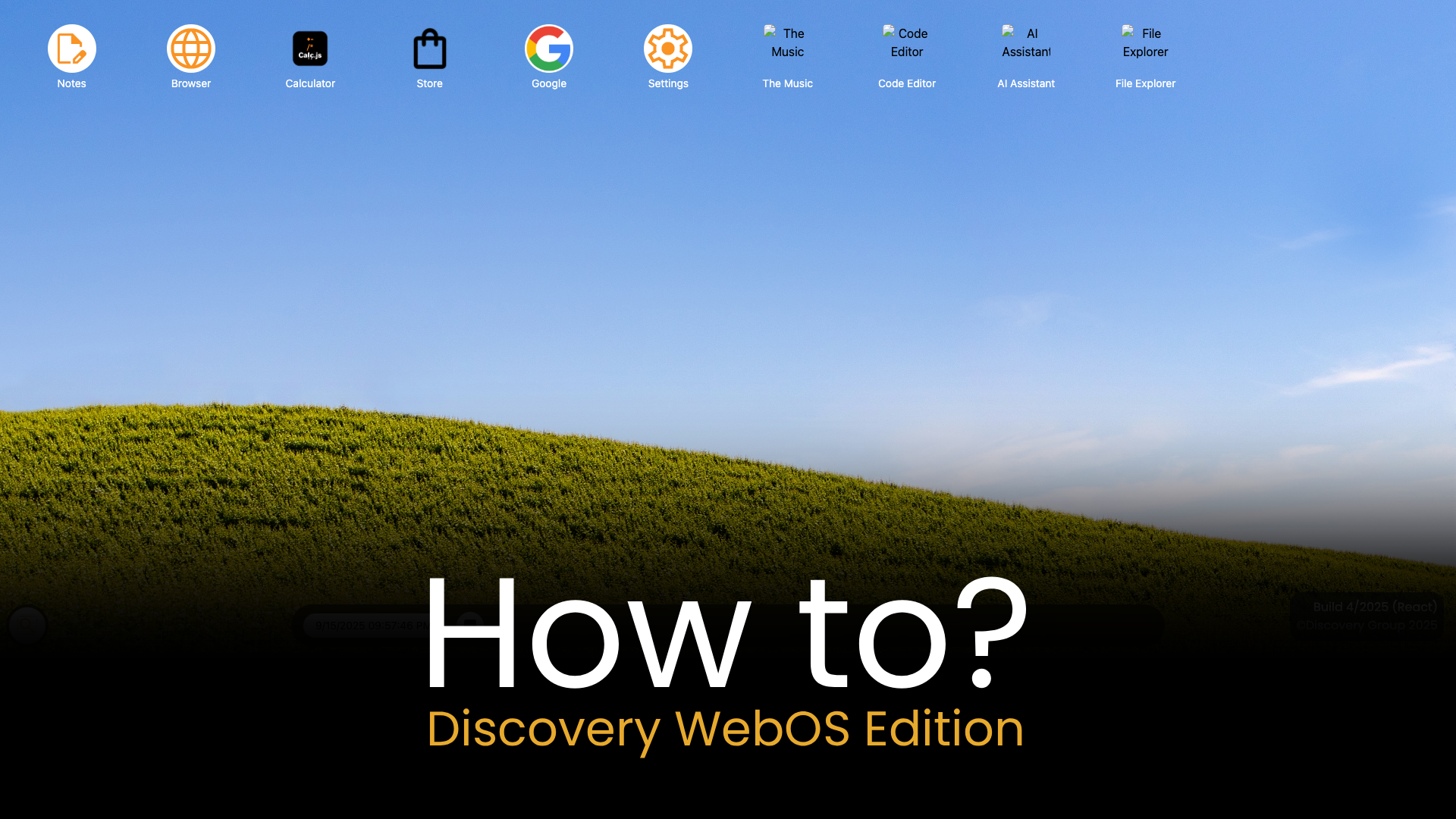Web‑OS User Manual
This guide summarizes hotkeys, features, and how to use the built‑in tools including Spatial Grid, Spatial Switcher, Code Editor, DSS (Discovery Service Script), and the Execute app.
Quick Hotkeys
- Start Menu: press
Win / Optionto trigger. - Spotlight Search:
Ctrl+Space. - Tab Switcher (AltTab):
Win+Tab/Option+Tab.
- Tab Switcher navigation (when open):
- Arrows: move selection between window cards.
- Enter: focus selected window.
- Escape: close Tab Switcher.
- Shift+Left/Right: move selected window to previous/next desktop (Spatial Switcher).
- Execute app:
Ctrl / Cmd+Enterto run the current DSS script.
Desktop, Windows, and Taskbar
- Open apps from desktop icons, Start Menu (lower‑left), or Spotlight.
- Window controls (top‑right): maximize, close.
- Drag via the window’s top bar (disabled while snapped).
- Snapped windows animate into halves (left/right/top/bottom). Maximizing clears snap.
- Taskbar (bottom center): shows time, Tab Switcher, Spotlight, App Manager, and running apps. Click an app badge to minimize/restore.
Tab Switcher (Overview)
Tab Switcher is a full‑screen overlay that helps you manage windows and desktops (Spaces). Open with Win+Tab or Option+Tab or the Taskbar button.
Two modes (set in Settings → Interface → Tab Switcher):
- Spatial Grid (default): iPad‑style grid of live window cards.
- Hover a card to reveal actions (Minimize, Close).
- Keyboard: arrows to move selection, Enter to open, Esc to close.
- Spatial Switcher: (advance)
- Top Spaces bar: up to 3 desktops. Click to switch.
- Drag & drop a window card onto a Space to move it.
- Hover a card for actions: move to previous/next desktop, Minimize, Close.
- Keyboard: arrows to move selection, Enter to open, Esc to close,
Shift+Left/Rightto send selected window to another desktop. - Switching desktops minimizes current desktop windows, then restores (or opens) windows assigned to the target desktop with a zoom transition.
Settings
Open the Settings app and adjust:
- General → Theme (Light/Dark/Windows 8/Cyberpunk).
- Interface → Tab Switcher → Style:
Spatial GridorSpatial Switcher. - Personalized → Background (select default or custom URL).
- Other interface and performance toggles (taskbar transparency, animations, etc.).
Code Editor (+ dss: links)
- The Code Editor renders HTML in a live preview (top).
- You can add DSS actions as links in your HTML using the custom
dss:scheme, for example:
<a href="dss: notify "Hello" "From DSS" type=success">Alert DSS</a>
Clicking such a link posts a DSS command to the OS to execute.
DSS (Discovery Service Script)
DSS is a tiny scripting language that triggers OS features like notifications, prompts, opening apps, and theme changes.
- Where to run DSS:
- Execute app (see below) — best for multi‑line scripts.
- dss: links embedded in your HTML (Code Editor preview).
- Syntax basics:
- Strings in quotes:
"Hello" - Options as
key=value:type=success - Comments start with
# - Capture result into a variable:
... -> $var - Interpolate variables:
${var}
- Core commands:
notify "Title" "Message" type=success|warning|error— Shows a toast and stores it in Notifications.prompt "Title" "Message" type=confirm|alert -> $ok— Shows a DiscoveryPrompt; capturestrue/falseinto$okifconfirm.open "App Title" route=#hash— Opens a system or custom app; appendsrouteto its URL.theme "light|dark|win8|cyberpunk"— Immediately applies and persists the theme.sleep 500— Waits (ms).set key "value"/get key -> $var— Persist to/read from localStorage.send "App Title" type=EVENT payload={...}— Posts a message to an app iframe by title (or broadcast to all if omitted). Apps can listen viawindow.addEventListener('message', ...).if <expr> then <command>— Runs one command if the expression is truthy. Example:if $ok then notify "Done" "User confirmed" type=success.
- Example script:
prompt "Settings?" "Open Interface page" type=confirm -> $ok
if $ok then open "Settings" route=#interface
notify "Finished" "Settings opened" type=success
Execute App (DSS Runner)
- Open the Execute app to run DSS in a dedicated editor.
- Toolbar controls:
- Run DSS: executes the text area. Shortcut:
Ctrl/Cmd+Enter. - History: pick from your last 12 scripts; Clear history to wipe.
- Commands: insert common presets (Notify, Prompt with capture, Open Settings, Theme).
- Type your script in the text area and click Run.
Troubleshooting
- A hotkey doesn’t work: Your OS may intercept it. Use the Taskbar button or the fallback key combos listed above.
- External sites: For security, third‑party pages load in iframes or new tabs. Use the Code Editor + dss: links or DSS for OS actions.
- Windows not moving during snap: Ensure the window is focused; try the fallback snap keys; press the same snap again or
Ctrl+Alt+0to unsnap.
---
DSS Stands for: Discovery Service Script<br>
Support: darkinc.cloud
Copyright 2025 Dark Inc. & Discovery Group All rights reserved.
<br>
(iPad is a trademark of Apple Inc.)
